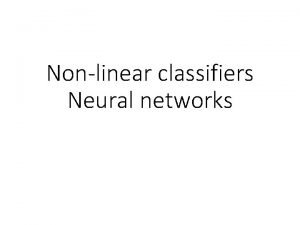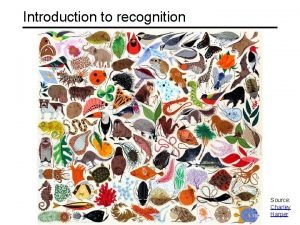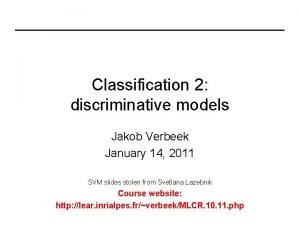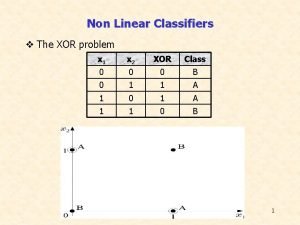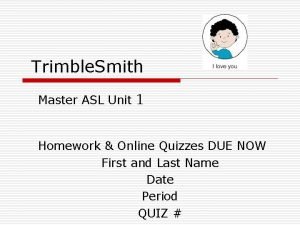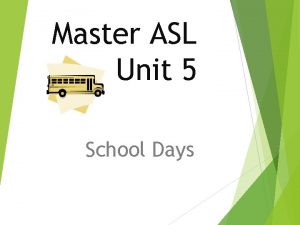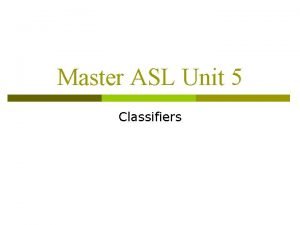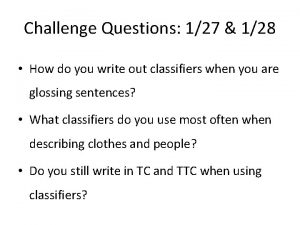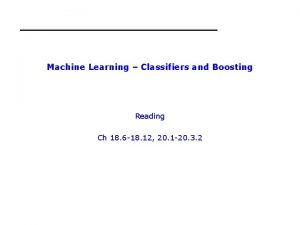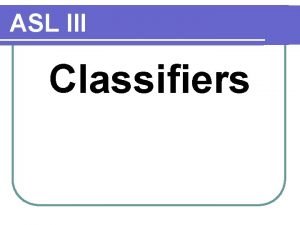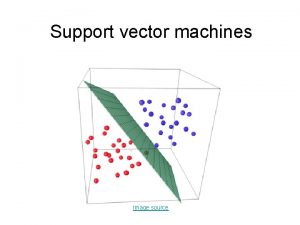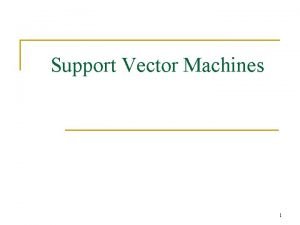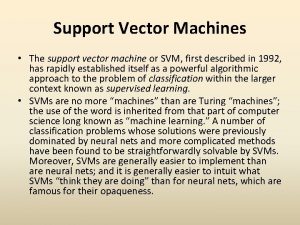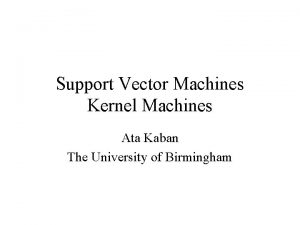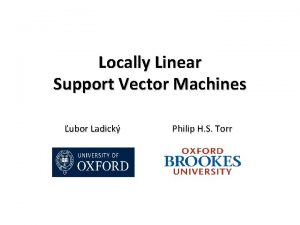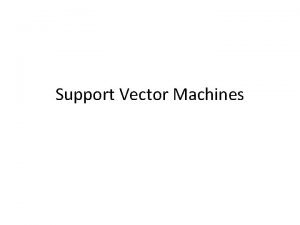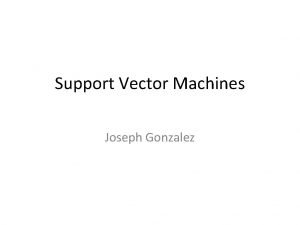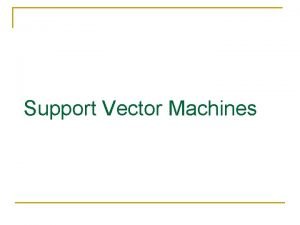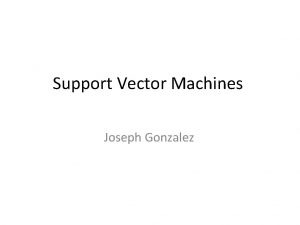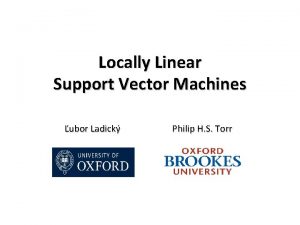An Introduction to Support Vector Machines Linear classifiers


















- Slides: 18

An Introduction to Support Vector Machines

Linear classifiers: Which Hyperplane? • Lots of possible solutions for a, b, c. • Some methods find a separating hyperplane, but not the optimal one [according to some criterion of expected goodness] – E. g. , perceptron • Support Vector Machine (SVM) finds an optimal* solution. Ch. 15 This line represents the decision boundary: ax + by − c = 0 – Maximizes the distance between the hyperplane and the “difficult points” close to decision boundary – One intuition: if there are no points near the decision surface, then there are no very uncertain classification decisions 2

Sec. 15. 1 Another intuition • If you have to place a fat separator between classes, you have less choices, and so the capacity of the model has been decreased 3

Sec. 15. 1 Support Vector Machine (SVM) Support vectors • SVMs maximize the margin around the separating hyperplane. • A. k. a. large margin classifiers • The decision function is fully specified by a subset of training Maximizes samples, the support vectors. Narrower margin • Solving SVMs is a quadratic margin programming problem • Seen by many as the most successful current text *but other discriminative methods 4 often perform very similarly classification method*

Main Ideas • Max-Margin Classifier – Formalize notion of the best linear separator • Lagrangian Multipliers – Way to convert a constrained optimization problem to one that is easier to solve • Kernels – Projecting data into higher-dimensional space makes it linearly separable • Complexity – Depends only on the number of training examples, not on dimensionality of the kernel space!

Tennis example Temperature Humidity = play tennis = do not play tennis

Linear Support Vector Machines Data: <xi, yi>, i=1, . . , l xi R d yi {-1, +1} x 2 =+1 =-1 x 1

Linear SVM 2 Data: <xi, yi>, i=1, . . , l xi R d yi {-1, +1} f(x) =-1 =+1 All hyperplanes in Rd are parameterize by a vector (w) and a constant b. Can be expressed as w • x+b=0 (remember the equation for a hyperplane from algebra!) Our aim is to find such a hyperplane f(x)=sign(w • x+b), that correctly classify our data.

Definitions Define the hyperplane H such that: xi • w+b +1 when yi =+1 xi • w+b -1 when yi =-1 H 1 and H 2 are the planes: H 1: xi • w+b = +1 H 2: xi • w+b = -1 The points on the planes H 1 and H 2 are the Support Vectors H 1 H 2 d+ = the shortest distance to the closest positive point d- = the shortest distance to the closest negative point The margin of a separating hyperplane is d+ + d-. d+ d- H

Maximizing the margin We want a classifier with as big margin as possible. H 1 Recall the distance from a point(x 0, y 0) to a line: Ax+By+c = 0 is|A x 0 +B y 0 +c|/sqrt(A 2+B 2) H H 2 d+ d- The distance between H and H 1 is: |w • x+b|/||w||=1/||w|| The distance between H 1 and H 2 is: 2/||w|| In order to maximize the margin, we need to minimize ||w||. With the condition that there are no datapoints between H 1 and H 2: xi • w+b +1 when yi =+1 xi • w+b -1 when yi =-1 Can be combined into yi(xi • w) 1

Constrained Optimization Problem

Quadratic Programming • Why is this reformulation a good thing? • The problem is an instance of what is called a positive, semi-definite programming problem • For a fixed real-number accuracy, can be solved in O(n log n) time = O(|D|2 log |D|2)

Problems with linear SVM =-1 =+1 What if the decision function is not a linear?

Kernel Trick

Other Kernels The polynomial kernel K(xi, xj) = (xi • xj + 1)p, where p is a tunable parameter. Evaluating K only require one addition and one exponentiation more than the original dot product. Gaussian kernels (also called radius basis functions) K(xi, xj) = exp(||xi-xj ||2/2 2)

Overtraining/overfitting A well known problem with machine learning methods is overtraining. This means that we have learned the training data very well, but we can not classify unseen examples correctly. An example: A botanist really knowing trees. Everytime he sees a new tree, he claims it is not a tree. =-1 =+1

Overtraining/overfitting 2 A measure of the risk of overtraining with SVM (there also other measures). It can be shown that: The portion, n, of unseen data that will be missclassified is bounded by: n Number of support vectors / number of training examples Ockham´s razor principle: Simpler system are better than more complex ones. In SVM case: fewer support vectors mean a simpler representation of the hyperplane. Example: Understanding a certain cancer if it can be described by one gene is easier than if we have to describe it with 5000.

References http: //www. kernel-machines. org/ http: //www. support-vector. net/ AN INTRODUCTION TO SUPPORT VECTOR MACHINES (and other kernel-based learning methods) N. Cristianini and J. Shawe-Taylor Cambridge University Press 2000 ISBN: 0 521 78019 5 Papers by Vapnik C. J. C. Burges: A tutorial on Support Vector Machines. Data Mining and Knowledge Discovery 2: 121 -167, 1998.
 Transductive support vector machines
Transductive support vector machines Linear classifiers
Linear classifiers Cs stanford
Cs stanford Linear classifiers
Linear classifiers Non linear classifiers
Non linear classifiers Asl classifiers worksheet
Asl classifiers worksheet Soda machine in asl
Soda machine in asl Asl classifiers worksheet
Asl classifiers worksheet Asl classifiers worksheet
Asl classifiers worksheet Kuai measure word
Kuai measure word Asl classifiers examples
Asl classifiers examples Bill vicars
Bill vicars Lifeprint classifiers
Lifeprint classifiers Asl classifiers examples
Asl classifiers examples Lifeprint classifiers
Lifeprint classifiers Lshow
Lshow Directed line segment definition geometry
Directed line segment definition geometry Vector unitario formula
Vector unitario formula Vector resolution
Vector resolution

